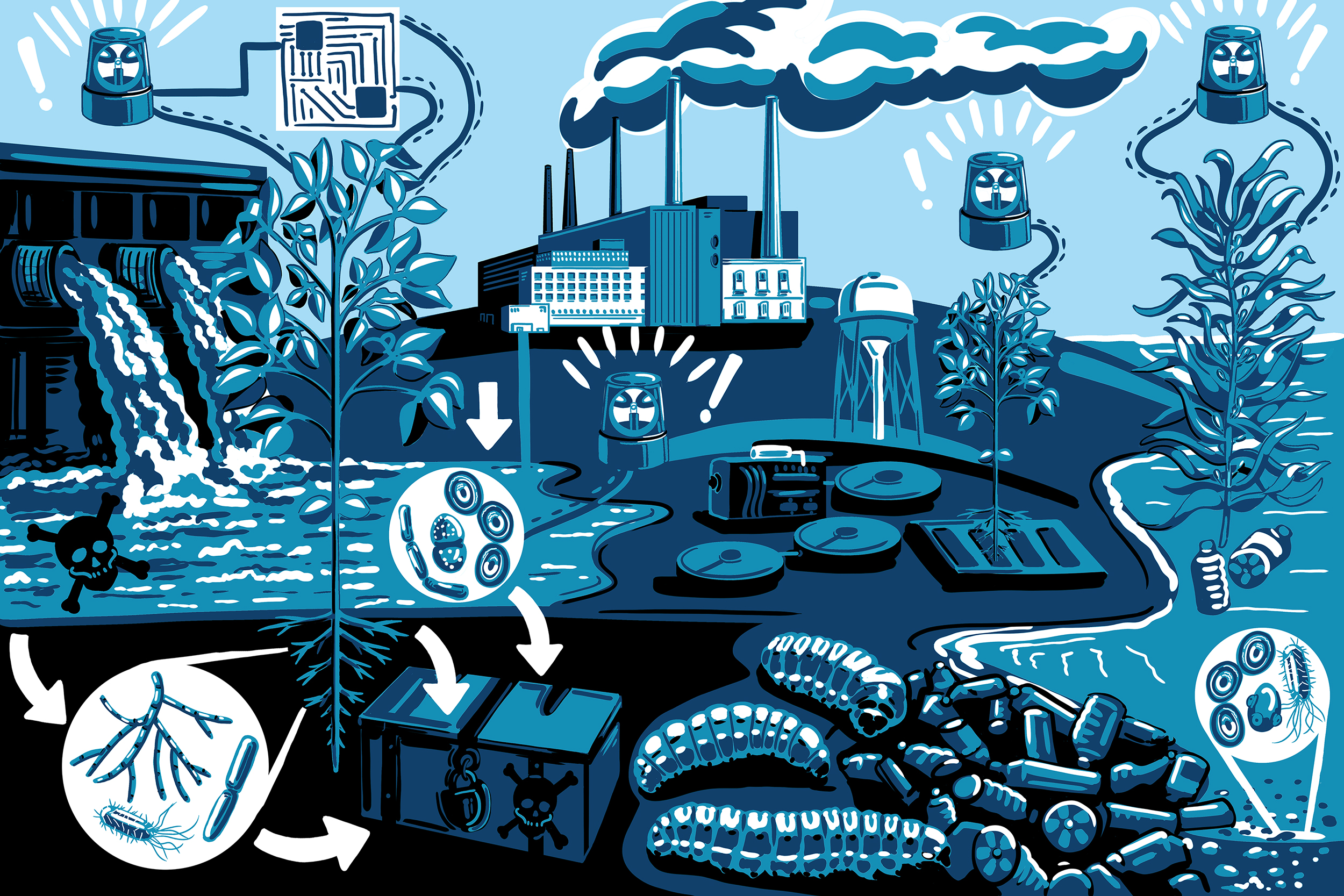Engineering Biology for Climate & Sustainability
Mitigation of Environmental Pollution
Mitigation of Environmental Pollution highlights opportunities for engineering biology to prevent and tackle pollution through bioremediation, biosequestration, and biodegradation of contaminants in the environment and from point-sources.
Introduction
Environmental contamination and pollution are unfortunate hallmarks of the anthropocene. Human population growth and inadequate environmental stewardship are causing significant impacts that ripple through human interactions with each other and the planet’s land and water. Urbanization and advanced technological capabilities and capacity have resulted in human uses of natural resources in unsustainable ways that damage, pollute, deplete, or destroy natural environments. Further, climate change is worsening natural disasters (floods, storms, fires) that contribute to new and more frequent environmental disturbance and contamination. Fortunately, the rich diversity of biological systems can inspire biobased solutions to this grand challenge. This roadmap technical theme considers opportunities to leverage biology to help protect biology, as well as other elements of the broader biosphere, by engineering biological solutions to mitigate environmental pollution and contamination.

Mitigating environmental pollution with engineering biology. Climate change and human activity are leading to increased pollution and contamination of the environment. With engineering biology, we have the opportunity to collect and degrade many types of waste from many different sources. Through the use of embedded engineered biosensors, such as in biomaterials or engineered plants, or biosensing and reporting cell-free systems, we could continuously monitor and detect contaminants entering the environment. Engineering microbes and other biosystems could be used to sequester and degrade particularly problematic pollutants, including plastic waste, PFAS , and heavy metals. Pollution and contaminants could also be targeted at specific known sources ripe for integration of engineered biological technologies, including municipal wastewater and sites of industrial effluent. Advancements will need to be made in the biological detection and reporting of specific molecules and compounds, engineering of enzymes capable of targeted contaminant degradation, and the robustness of biosystems to complex and toxic environments.
To adequately prevent and mitigate pollution, robust monitoring capabilities must be employed to identify pollutant sources and the locations of greatest accumulation and impact. Engineering biology can help to enable strategies to monitor these contaminants, ultimately informing and contributing to the development of tools for removal, mitigation, and remediation. For example, massively scalable point-of-use biosensing technologies could empower individuals to monitor their own environmental quality; such data would support efforts to advocate for environmental justice in marginalized communities. Affordable water quality biosensors could prevent acute and chronic illnesses. And continuous environmental quality monitoring capabilities could inform ‘smart cities’ approaches to tackle pollution challenges in urban environments.
Anthropogenic activities like mining, agriculture, and manufacturing introduce an assortment of contaminants into the environment, including plastic, heavy metals, excess nutrients, and harsh chemicals. These contaminants can cause significant disruptions to land and aquatic ecosystems, damage wildlife in these environments,, and adversely affect human health., Engineering biology can enable bioremediation through bio-enabled sequestration and degradation of harmful pollutants. Some of the most impactful pollutants we currently face, and have chosen to address in this roadmap, include plastic waste, per- and polyfluoroalkyl substances, and heavy metals, including electronics waste. This roadmap considers microbial engineering and other biotechnologies that can contribute to the capture and degradation of these pollutants.
Climate change is expected to exacerbate the risks these contaminants pose to the environment., In order to maintain healthy populations and ecosystems, we need to consider how we can mitigate pollution from select environments where the impacts of contaminants can have particularly wide ranging and harmful downstream effects. This technical theme considers three of those circumstances: contamination in municipal wastewater, contaminants stemming from agriculture and aquaculture, and industrial effluent, which often contains harsh chemical waste. Bioremediation can help to ensure safe drinking water, beaches and waterways free of harmful bacteria and algae, and safer industrial and urban environments.
Environmental remediation in Microbiome Engineering
EBRC’s 2020 roadmap, Microbiome Engineering: A Research Roadmap for the Next-Generation Bioeconomy, identified a number of ways that engineered microbiomes, in particular, could be used to mitigate and remove pollutants from the environment. These objectives and achievements include employing microbiomes to sense and sequester contaminants, degrade plastic waste, and improve water treatment processes.
View →
